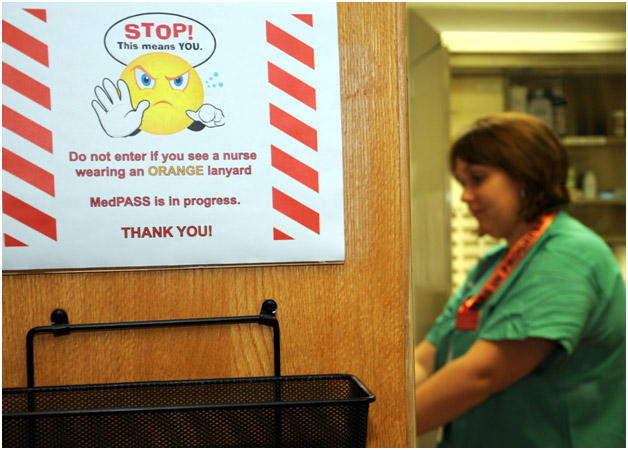USAISR Burn Center Designs Program to Avoid Medication Errors

When it is time for Staff Sgt. Darius Johnson to take his medication, his nurse will bring it to his room and administer it. Before his nurse hands the medication to him, she will ask to state his name and date of birth. This routine is all part of a evidence-based program called MedPASS that was implemented at the U.S. Army Institute of Surgical Research (USAISR) Burn Center's 4 East Progressive Unit. MedPASS was put into practice by a team of nurses who researched for methods being used at hospitals around the world to avoid medication errors.
Clinical Nurse Specialist Ana Cocke, who headed the project, said that after reviewing all available literature on preventing medication errors, they came up with MedPASS. In order to launch the program they established that there were two elements necessary to execute MedPASS. "Our goal was to come up with a program that would ensure fewer interruptions to decrease mistakes. The first thing we had to come up was to create a safe zone where nurses prepare the medications without being interrupted," said Cocke. "Then we had to design a visible symbol that is worn by the nurses that indicates that they are preparing and administering medications and that they should not be disturbed or disrupted."
The safe zone can only be occupied by the nurse when preparing medications for patients and the visible symbol is a bright orange lanyard that is worn to signify that nurse is administering medications. While the nurse is wearing the lanyard, no one is allowed to distract or disturb them.
"The majority of medication errors occur when a nurse who is administering medications is interrupted," Cocke said. "If we can prevent from interrupting a nurse while preparing and disbursing medications, then we will decrease medication errors."
In order for MedPASS to be successful, everyone who works in the ward, including the patients and housekeepers, had to be made aware of the program and support it. Carrie Hatch, a licensed vocational nurse at 4 East, said that when MedPASS was initially put into operation she thought it was impractical. Once she learned the purpose of the lanyard, the safe zone and the intent of the program she fully supported it. "I think it's a great idea," said Hatch. "If this will reduce the risk of medication errors, then I fully support it."
"And that's what we need," said Cocke. "We need the support of everyone, not only for MedPASS, but to support each other in order for it to be successful."
Cocke said that it will take months before they can measure the result of the program. "We have a database where we enter every near mishap," she said. "It's called the Patient Safety Report and we insert every incident into the database. After months of recording and reviewing the data, we will be able to determine whether MedPASS is successful or not."
For patients like Johnson, a program like this reassures him that the nurses who are giving him his medication are devoting all their attention to ensuring he is getting the correct dosage and proper medication. "It makes me feel good knowing that they are doing this," said Johnson. "When I first got here I was told about it and how it works. I know that what I'm taking is what I'm supposed to be taking. It makes me feel comfortable and safe."
"I'm happy that we are doing this," said Hatch. "It helps me stay complacent."
"It helps to keep you on your toes and on top of your game," said Spec. Belinda A. Rogers, a licensed vocational nurse at 4 East. "I like it because I'm more cautious and aware of what I'm doing."
"And that's important," Cocke said. "We've noticed that there's greater job satisfaction and we've had some positive feedback from the physicians. Anytime that you can implement a nurse-driven, evidence-based, process improvement program that's designed to decrease mistakes that could harm a patient, then it's a program worth pursuing."














